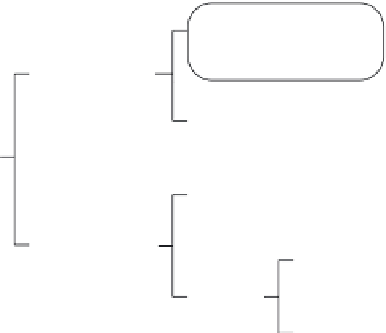Environmental Engineering Reference
In-Depth Information
ing that a N/P ratio on the order of 10 is utilized in plant
growth. Hence, if the ratio of available nitrogen to avail-
able phosphorus in the water significantly exceeds 10,
phosphorus would be the limiting nutrient, whereas if
the N/P ratio in the water is significantly less than 10,
nitrogen would be the limiting nutrient. A relationship
developed by Stumm and Morgan (1962) indicated that
1 atom of phosphorus and 16 atoms of nitrogen are
needed to generate 154 molecules of oxygen during
photosynthesis (this ratio of nitrogen to phosphorus is
called the
Redfield ratio
), and Ryther and Dunstan
(1971) reported that N/P ratio requirements for the
growth of microalgae are in the range of 3-30, with an
average of 16. An alternative approach to determining
whether nitrogen or phosphorus is the limiting nutrient
is to plot the nitrogen concentrations versus phosphorus
concentrations on an arithmetic plot. The straight line
of best fit will intercept either the nitrogen or phospho-
rus axis, and the nutrient that is exhausted first (deter-
mined by the intercept) is the limiting nutrient. In a
related approach, some studies have used the correla-
tion of phosphorus and nitrogen levels to chlorophyll
a
concentrations to identify the limiting nutrient (Gin and
Neo, 2005). The limiting nutrient is the one that is most
correlated with chlorophyll
a
.
The control of eutrophication usually requires the
specification of a target biomass concentration in terms
of
µ
g chlorophyll
a
/L (
µ
g Chl
a
/L); typical target biomass
concentrations in northern temperate lakes are in the
range of 1-4
µ
g Chl
a
/L for oligotrophic lakes and
5-10
µ
g Chl
a
/L for eutrophic lakes. Many lake models
assume
a priori
that phosphorus is the limiting nutrient,
in which case the biomass (chlorophyll
a
) concentration,
c
b
, in a water body is estimated based on the TP concen-
tration. This approach implicitly assumes a stable
relationship between TP and available phosphorus
(orthophosphate,
PO
4
−
), and neglects other variables
that affect algal growth, such as sedimentation, preda-
tion, nutrient recycling, and oxygen fluxes. Several
empirical relations between
c
b
and TP are listed in
Table 7.1, where both
c
b
and TP are in
µ
g/L. The variety
of formulas in Table 7.1 reflect the seasonal, climatic,
ecological, and hydrologic variations between the lakes
for which these relationships were determined. The
relations given in Table 7.1 should be used with caution
since they are not valid for all values of TP. According
to Jørgensen et al. (2005), with increasing concentra-
tions of TP, the algal biomass first increases slowly, and
then more rapidly, followed by an almost linear rise
until some asymptotic value of biomass is reached at
high concentrations of TP. A consequence of this non-
linear relation is that when the concentrations in a
lake are very high prior to external phosphorus
load reductions, even a very significant decrease in the
available for phytoplankton growth
dissolved reactive
phosphorus
(orthophosphorus)
total dissolved
complex dissolved organic
phosphorus
total
phosphorus
(TP)
inorganic
total particulate
detritus
organic
phytoplankton
Figure 7.5.
Components of total phosphorous.
detritus
particulate
organic nitrogen
phytoplankton
dissolved
total nitrogen
(TN)
available for phytoplankton growth
ammonia nitrogen
NO
2
and NH
3
nitrogen
inorganic nitrogen
Figure 7.6.
Components of total nitrogen.
and TN are illustrated in Figures 7.5 and 7.6. Since not
all components of TP and TN are available for uptake
by phytoplankton, it is important to delineate the com-
ponents that are present in the water. The two principal
components of TP are the dissolved and particulate
forms. Dissolved phosphorus includes several forms, of
which dissolved reactive phosphorus (orthophosphate,
PO
4
−
) is available for phytoplankton growth. Available
phosphorus is commonly taken to be orthophosphate
that passes a 0.45-
µ
m membrane filter. The principal
components of TN are organic, ammonia, nitrite (NO
2
),
and nitrate (NO
3
) forms, of which ammonia, nitrite, and
nitrate forms are utilized by phytoplankton for growth.
The design of systems to control eutrophication are
based on identifying the limiting nutrient and determin-
ing the allowable nutrient levels to maintain a desirable
concentration of plant biomass in the water. The limit-
ing nutrient can be identified by comparing the ratio of
nitrogen to phosphorus (N/P) in the water that is avail-
able for plant growth to the ratio of nitrogen to phos-
phorus required for plant growth. A consideration of
the cell stoichiometry of phytoplankton shows a phos-
phorus content of 0.5-2.0
µ
g P/
µ
g chlorophyll
a
and a
nitrogen content of 7-10
µ
g N/
µ
g chlorophyll
a
, indicat-




Search WWH ::

Custom Search